What Kind of Techniques Does Ai Weiwei Uses for His Art
Ai Weiwei: xiii works to know
Published 15 September 2015
Ai Weiwei has worked in everything from pigment to readymades. As our landmark exhibition examines work from 1993 up to the nowadays day, we take a look at some of the cardinal works to know from across Ai's career.
-
In Ai Weiwei's work, there is no sectionalization between fine art and politics. Throughout his career, the creative person has never shied away from hard truths and has resolutely fought for liberty of expression. Through sculpture, motion picture, installation, photography and architecture – and across an assortment of materials including ceramics, marble, paint and tea – he has campaigned for human rights with works dealing with oppression, celebration and Chinese identity and social history, equally poignant as they are provocative. Detect out more about Ai Weiwei's life and piece of work in our beginner'south guide.
Here, nosotros take a quick look at xiii fundamental works throughout his career.
-
Still Life, 1993–2000
-
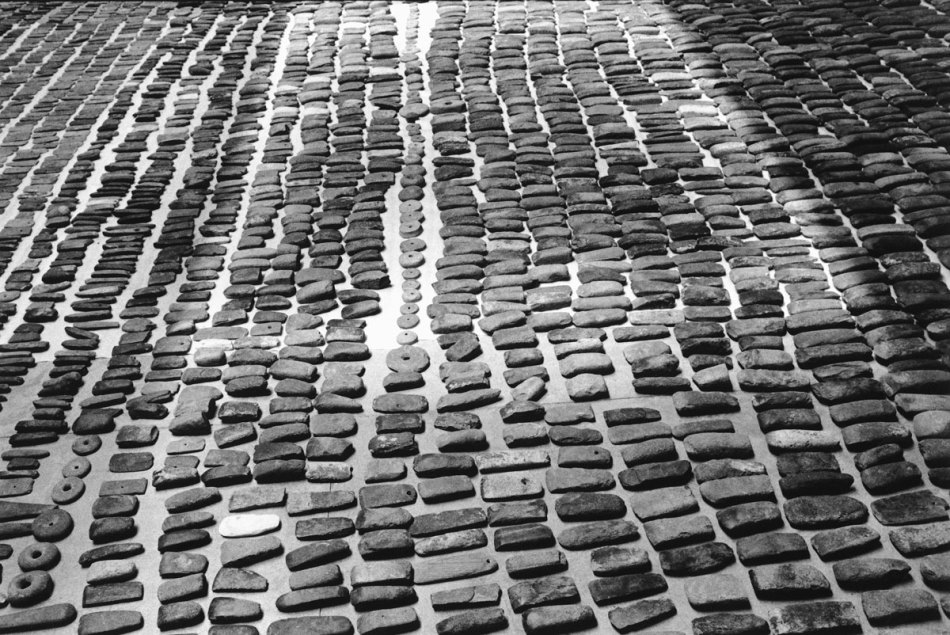
Ai Weiwei, Still Life, 1993–2000.
Still Life is an installation of around four,000 stone axe-heads – dating dorsum to China's Rock Age, around 6000 BC – painstakingly laid out on the floor. The piece of work advise's Ai Weiwei's complex feelings surrounding China's handling of social history.
Dimensions variable. 3,600 stone tools dating from the Stone Historic period to the Shang Dynasty (10,000-1100 BC). Image courtesy of Ai Weiwei Studio © Ai Weiwei.
-
Dropping a Han Dynasty Urn, 1995
-
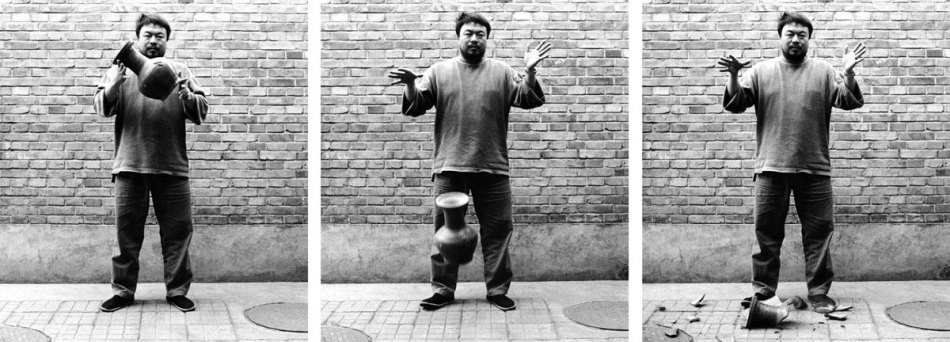
Ai Weiwei, Dropping a Han Dynasty Urn, 1995.
In 1995, Ai smashed an antique urn. He had became fascinated with Red china'southward traditional heritage that Mao had tried to wipe out during the Cultural Revolution (1966-76). He would visit antiquarian markets, gathering items that he'd learnt from Duchamp could be presented as artworks in themselves, or "readymades" – amid them, 2000 twelvemonth-old urns from the Han Dynasty. Creating what is still one of his nigh provocative works, the artist photographed himself dropping one.
3 blackness and white prints. Each 148 x 121 cm. Courtesy of Ai Weiwei Studio Image courtesy Ai Weiwei © Ai Weiwei.
-
'The Bird'southward Nest', National Stadium, Beijing, 2005–08
-
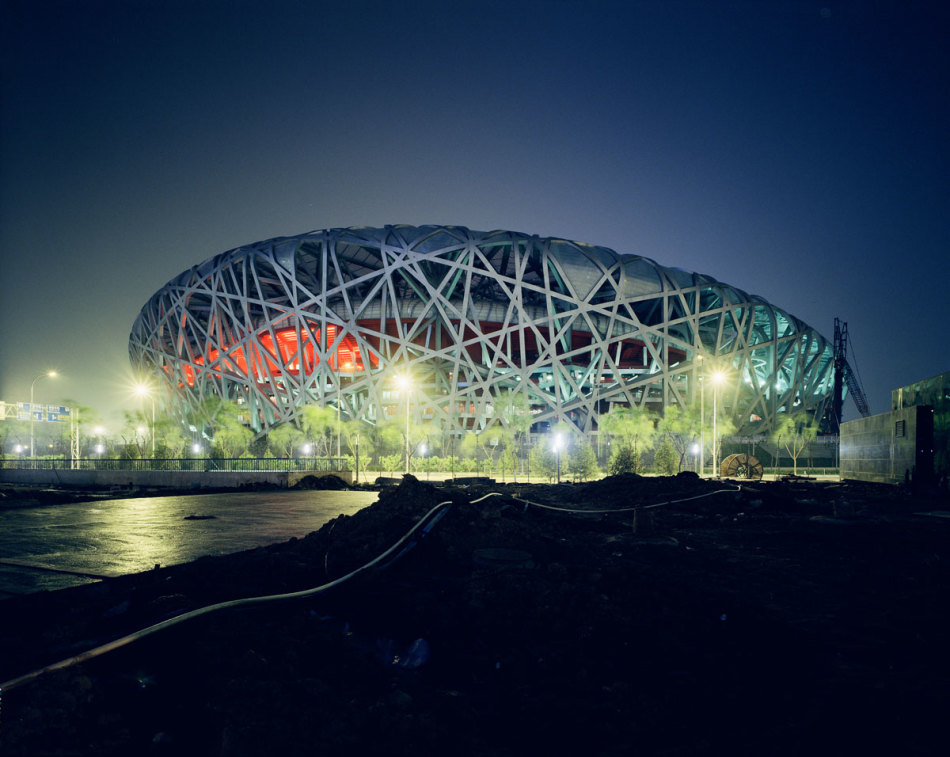
Ai Weiwei, 'The Bird'south Nest', National Stadium, Beijing, 2005–2008.
Nicknamed the 'Bird's Nest' because of its fretted structure, the National Stadium in Beijing was a collaboration betwixt Ai Weiwei and Swiss architects Herzog and de Meuron, built in the run-up to the 2008 Olympics. The stadium has since been a source of regret for Ai Weiwei. He boycotted the Olympics, highlighting the discrepancy between China's patriotic rhetoric and notwithstanding its terrible homo rights tape. "It was simply a stage for a political party to advertise its celebrity to the globe," he told Japanese newspaper Yomiuri Shimbun. "Since the Olympics, I haven't looked at it".
Image courtesy of Ai Weiwei Studio © Ai Weiwei.
-
Fragments, 2005
-
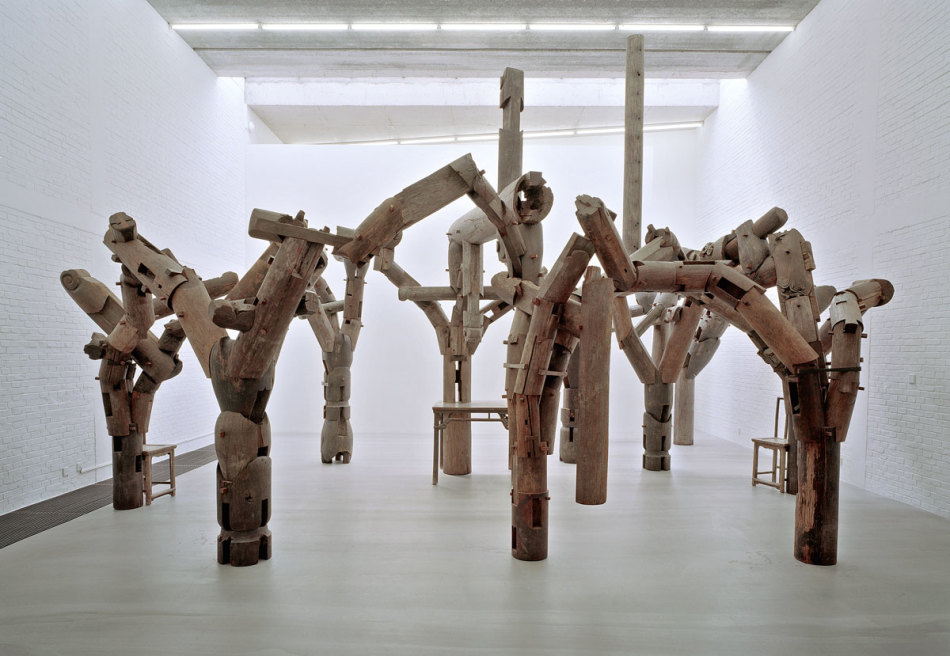
Ai Weiwei, Fragments, 2005.
For Fragments, Ai Weiwei salvaged pillars and beams of "tieli", Chinese ironwood, from demolished Qing dynasty temples, and worked with carpenters to create a structure of poles with linking arms. When viewed from above, it becomes credible that the anchored poles mark out the borders of a map of China.
500 x 850 x 700 cm. Fe wood (tieli wood) tabular array, chairs, parts of beams and pillars from dismantled temples of the Qing Dynasty (1644–1911). M + Sigg Collection, Hong Kong. By donation. Image courtesy of Ai Weiwei Studio © Ai Weiwei.
-
Template, 2007
-
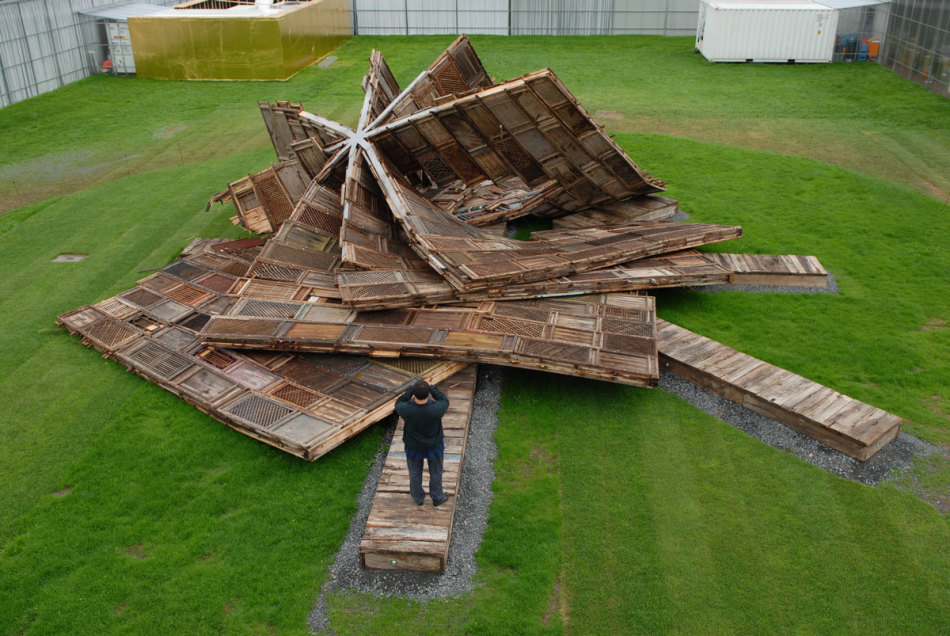
Ai Weiwei, Template, 2007.
Like many of Ai Weiwei'south works, Template relates to alter in Red china. It is composed of wooden doors and windows salvaged from Ming and Qing Dynasty houses which had been demolished to make way for new development. On displaying the installation outdoors in Frg in 2007, the structure collapsed after being exposed to wind and rain. Ai Weiwei embraced this change: "When I saw how the site had collapsed – turned into some other shape – I was quite impressed," he told Bloomberg. "It comes from ruins and now it's actually a ruin".
After collapsing at Documenta 12, Kassel, 2007. Wooden doors and windows from destroyed Ming and Qing Dynasty houses (1368–1911). Paradigm courtesy of Ai Weiwei Studio © Ai Weiwei.
-
Fountain of Light, 2007
-
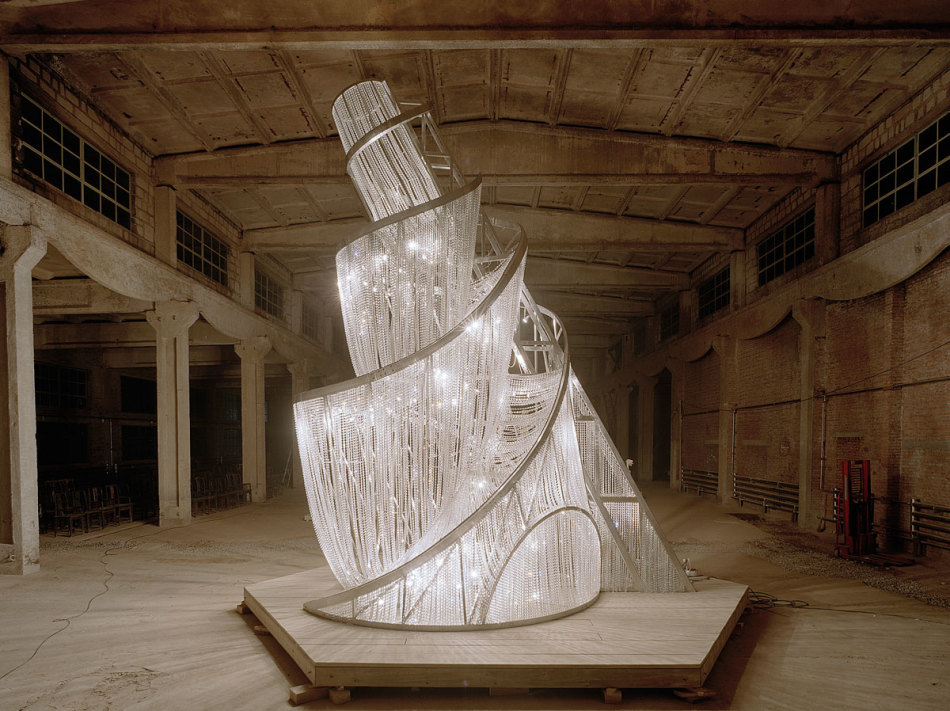
Ai Weiwei, Fountain of Light, 2007.
Shown at Tate Liverpool in 2007, Fountain of Lite is a glittering tiered chandelier of glass crystals over twenty feet high. It was inspired by Vladimir Tatlin's ambitious Communist monument in Russia – the Monument for the 3rd International, or "Tatlin's Tower" (recreated in miniature in the RA courtyard in 2012 for the exhibition Building the Revolution: Soviet Fine art and Architecture 1915-1935) – that, despite elaborate plans, was never built.
Steel and glass crystals on wooden base. 700 x 529 x 400 cm. Image courtesy of Ai Weiwei Studio © Ai Weiwei.
-
Straight, 2008–12
-
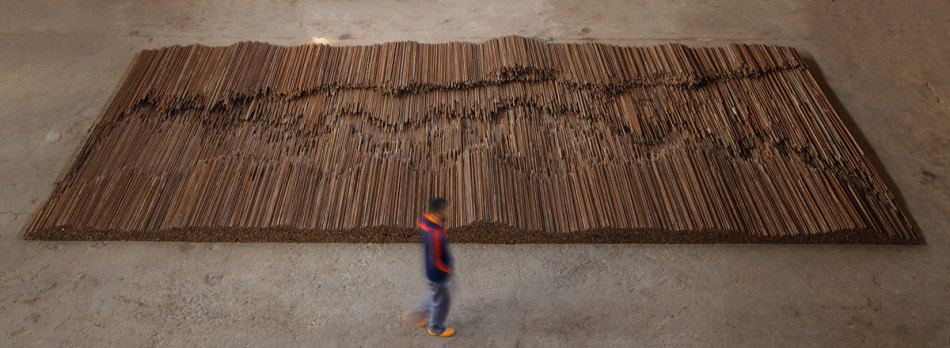
Ai Weiwei, Direct, 2008–12.
The largest gallery at the RA will house Straight, Ai Weiwei's poignant response to the Sichuan earthquake of 2008. Poorly congenital schools in the Sichuan province – held up by steel rods which twisted and mangled in the quake – were devastated, leaving thousands of students dead. These rods (which Ai had labourers straighten by hand) make up the 90-ton flooring-based sculpture, that is laid out in broken undulations recalling fault lines.
Steel reinforcing bars. 1200 ten 600 cm. Courtesy of Ai Weiwei Studio. Prototype courtesy of Ai Weiwei Studio © Ai Weiwei.
-
Remembering, 2009
-
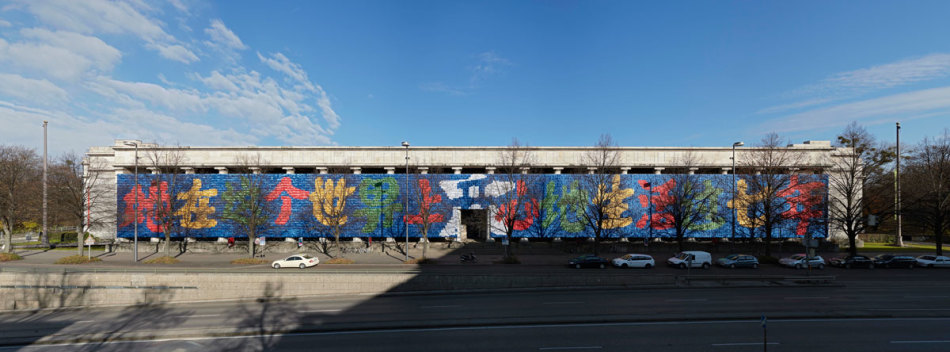
Ai Weiwei, Remembering, 2009.
Originally installed on the façade of the Haus der Kunst in Munich, Remembering is also a response to the Sichuan earthquake. Consisting of ix,000 schoolhouse children's backpacks, the different colours are arranged to depict the sentence, "For vii years she lived happily on this earth" in Chinese lettering, which was uttered by the mother of a small-scale girl who perished in the quake. After, Ai would talk of the negligence of the Chinese government for the poorly congenital schools which collapsed.
Installation on the façade of the Haus der Kunst, Munich. Paradigm courtesy of Ai Weiwei Studio © Ai Weiwei.
-
Sunflower Seeds, 2010
-
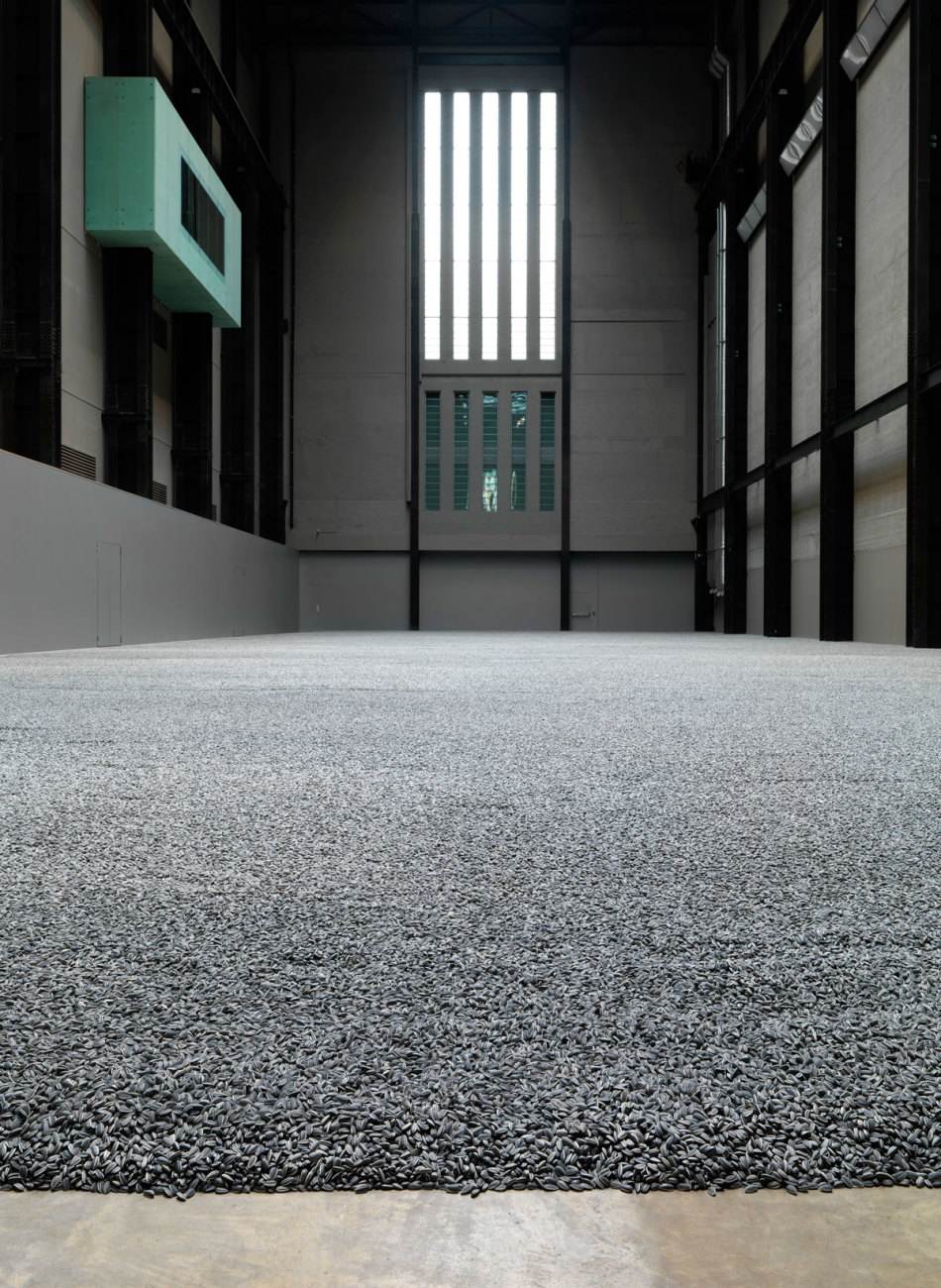
Ai Weiwei, Sunflower Seeds, 2010.
In 2011, Ai Weiwei'due south sunflower seeds – 100 one thousand thousand of them – were poured into the Turbine Hall at Tate Modern. Each one was unique: hand-crafted from porcelain in Jingdezhen – the Chinese town that in one case produced imperial porcelain for over a grand years. Information technology took 1,600 artisans over ii years to make the seeds, which were created out of the kaolin from local mountains, hand-painted and fired at ane,300 degrees. While the seeds were on display in London, Ai was arrested and detained without explanation by the Chinese regime for 81 days. During this flow, the RA elected Ai an Honorary Royal Academician, in solidarity.
Installation of 100 one thousand thousand painted porcelain seeds in the Turbine Hall at the Tate Modern, London. Photo © Tate, London 2015 © Ai Weiwei.
-
S.A.C.R.Due east.D., 2012
-
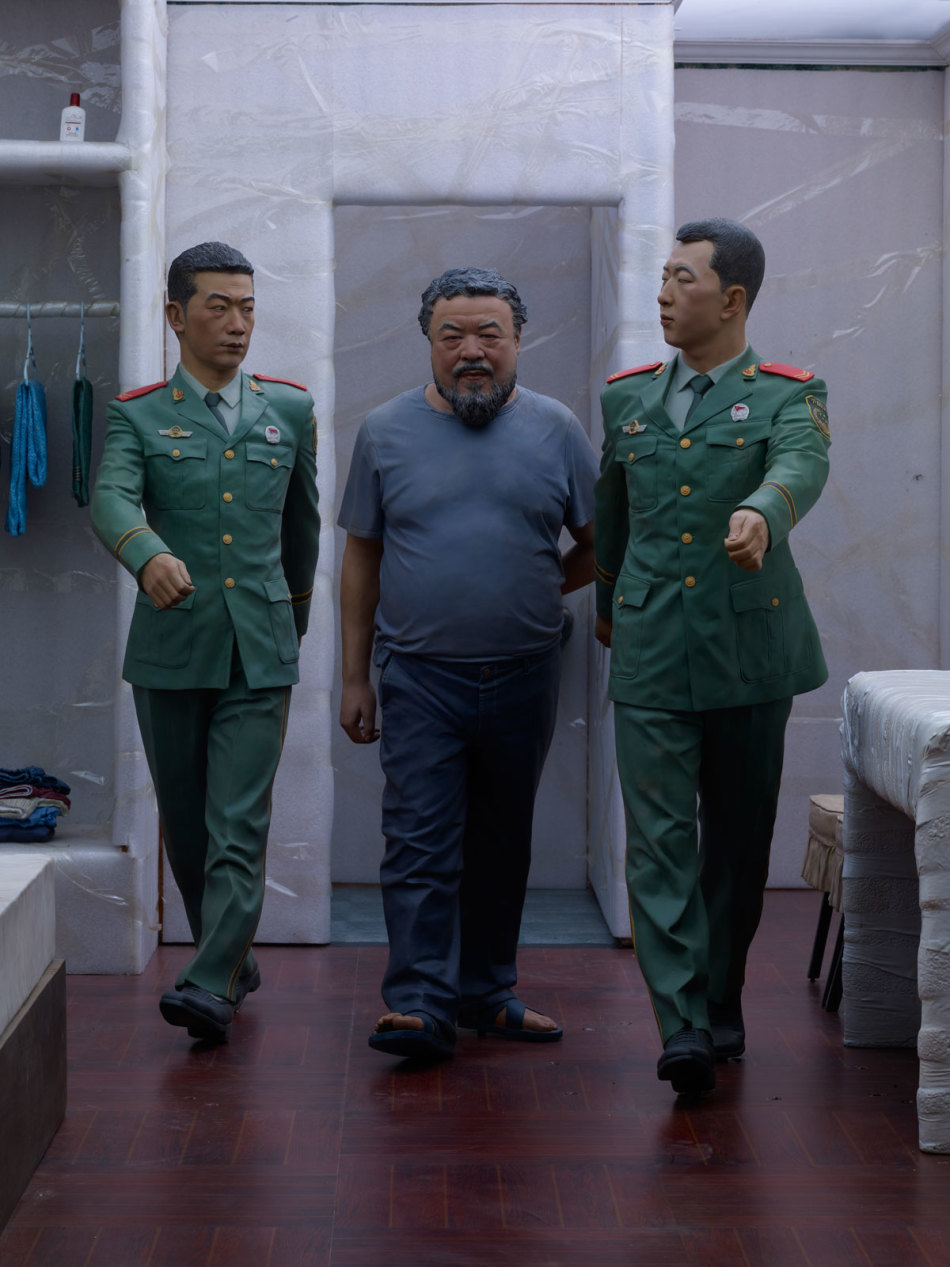
Ai Weiwei, Southward.A.C.R.Eastward.D., 2011-2013.
Ai's work Southward.A.C.R.E.D. reflects upon his time in detention. It takes the form of six atomic number 26 cuboids, which will stand in the RA gallery at shoulder summit. Through apertures in the metal façade of each cuboid, visitors will exist able to peer inside and view miniature dioramas of Ai's imprisonment, the artist and his guards replicated in fibreglass.
Fibreglass, iron, oxidized metal, wood, polystyrenen, sticky tape. Each 377 x 198 x 153 cm. Six-office work composed of six dioramas – Supper, Accusers, Cleansing, Ritual, Entropy, Uncertainty. Courtesy of Ai Weiwei Studio and Lisson Gallery. Image courtesy of Ai Weiwei Studio © Ai Weiwei.
-
Forever Bicycles, 2013
-

Ai Weiwei, Forever Bicycles, 2013.
In Forever – the latest of Ai'southward Forever Wheel series – the artist acknowledges his appreciation of Marcel Duchamp, and in detail Duchamp's first readymade, Bicycle Bicycle of 1913. This installation is a grouping of 1,179 stainless steel bicycle frames, held together in geometrical shapes. The sculpture's name refers to the Forever bicycle brand which has been producing bikes in Shanghai since 1940, and the work can be seen as both a reference to Chinese peasants (for whom the Forever bicycle was a primary ways of transport) and a comment upon the widespread mass production that fuels China's industries.
ane,179 Forever cycle frames, h. 10m. Installation at the 55th Venice Biennale, 2013. Courtesy of Lisson Gallery. Photography: Filippo Armellin © Ai Weiwei.
-
Stools, 2013
-

Ai Weiwei, Stools, 2013.
This installation at the Martin-Gropius-Bau in Berlin consisted of six,000 stools laid out in the gallery. The 3-legged wooden stools – originally produced by craftsmen – were typical of those used by Chinese families in the Ming Dynasty, which were replaced by metal and plastic models subsequently the Cultural Revolution. The work demonstrates the influence of Duchamp on Ai'southward work in his continued exploration of the cultural values of Mainland china expressed through everyday objects.
6,000 antique stools, dimensions variable. Installation at 'In Evidence', Martin-Gropius-Bau, Berlin, 2014. Paradigm courtesy of Ai Weiwei Studio © Ai Weiwei.
-
Ye Haiyan's Belongings, 2013
-

Ai Weiwei, Ye Haiyan'southward Belongings, 2013.
Ye Haiyan is an activist for women'south rights in Red china. In response to her activism, the Chinese government evicted her from her domicile, leaving her, her daughter and their luggage on the side of a thruway. Ai has helped Ye Haiyan financially since she became homeless, and eventually turned her hastily packed belongings into an artwork.
Installation at 'Ai Weiwei: According to What?', at the Brooklyn Museum of Fine art, New York. Image courtesy of Ai Weiwei Studio © Ai Weiwei.
-
Ai Weiwei is in the Primary Galleries of Burlington House from nineteen September until 13 December.
Source: https://www.royalacademy.org.uk/article/ai-weiwei-13-works-to-know